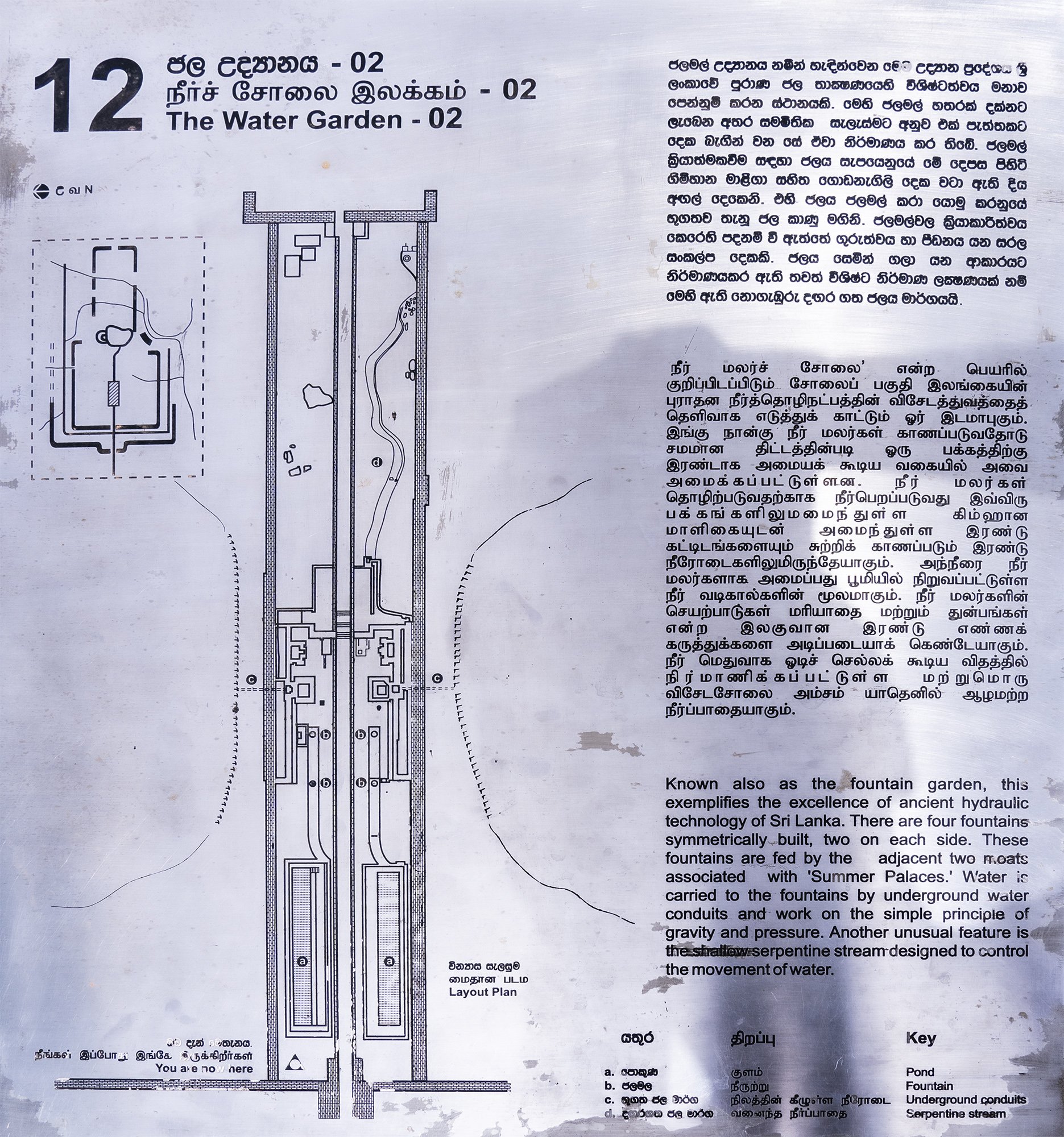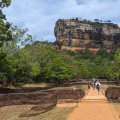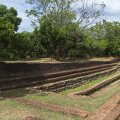Sigiriya rock fortress: photo 14
Photo 14 of 45 in Gallery: Sigiriya rock fortress

Image title: Water Garden (layout plan)
Description of the photo
English text:
The Water Garden (layout plan)—Known also as the fountain garden, this exemplifies the excellence of ancient hydraulic technology of Sri Lanka. There are four fountains symmetrically built, two on each side. These fountains are fed by the adjacent two moats associated with 'Summer Palaces.' Water is carried to the fountains by underground water conduits and work on the simple principle of gravity and pressure. Another unusual feature is the shallow serpentine stream-designed to control the movement of water.
Key:
a. Pond
b. Fountain
c. Underground conduits
d. Serpentine stream
In Sanskrit this would be known as Jala-udyāna [jalodyana]
Sinhala text (not proofread):
ජල උද්යානය (වින්යාස සැලසුම)—ජලමල් උද්යානය නමින් හැඳින්වෙන මෙම උද්යාන ප්රදේශය ශ්රී ලංකාවේ පුරාණ ජල තාක්ෂණයෙහි විශිෂ්ටත්වය මනාව පෙන්නුම් කරන ස්ථානයකි. මෙහි ජලමල් හතරක් දක්නට ලැබෙන අතර සමමිතික සැලැස්මට අනුව එක් පැත්තකට දෙක බැගින් වන සේ ඒවා නිර්මාණය කර තිබේ. ජලමල් ක්රියාත්මක වීම සඳහා ජලය සැපයෙනුයේ මේ දෙපස පිහිටි ගිම්හාන මාළිගා සහිත ගොඩනැගිලි දෙක වටා ඇති දිය අඟල් දෙකෙනි. එහි ජලය ජල මල් කරා යොමු කරනුයේ භූගතව තැනූ ජල කාණු මගිනි. ජලමල්වල ක්රියාකාරීත්වය කෙරෙහි පදනම් වී ඇත්තේ ගුරුත්වය හා පීඩනය යන සරල සංකල්ප දෙකකි. ජලය සෙමින් ගලා යන ආකාරයට නිර්මාණය කර ඇති තවත් විශිෂ්ට නිර්මාණ ලක්ෂණයක් නම් මෙහි ඇති නොගැඹුරු දඟර ගත ජලය මාර්ගයයි.
යතූර
a. පොකුණ
b. ජලමල
c. භූගත ජල මාර්ග
d. දඟරගත ජල මාර්ග
Transliteration:
jala udyānaya (vinyāsa sælasuma)—jalamal udyānaya namin hændinvena mema udyāna pradēśaya śrī laṅkāvē purāṇa jala tākṣaṇayehi viśiṣṭatvaya manāva pennum karana sthānayaki. mehi jalamal hatarak daknaṭa læbena atara samamitika sælæsmaṭa anuva ek pættakaṭa deka bægin vana sē ēvā nirmāṇaya kara tibē. jalamal kriyātmaka vīma sandahā jalaya sæpayenuyē mē depasa pihiṭi gimhāna māḷigā sahita goḍanægili deka vaṭā æti diya aṅgal dekeni. ehi jalaya jala mal karā yomu karanuyē bhūgatava tænū jala kāṇu magini. jalamalvala kriyākārītvaya kerehi padanam vī ættē gurutvaya hā pīḍanaya yana sarala saṅkalpa dekaki. jalaya semin galā yana ākārayaṭa nirmāṇaya kara æti tavat viśiṣṭa nirmāṇa lakṣaṇayak nam mehi æti nogæḅuru daṅgara gata jalaya mārgayayi.
yatūra
a. pokuṇa
b. jalamala
c. bhūgata jala mārga
d. daṅgaragata jala mārga
Transliteration:
jala udyanaya (vinyasa salasuma)—jalamal udyanaya namin handinvena mema udyana pradeshaya shri lankave purana jala takshanayehi vishishtatvaya manava pennum karana sthanayaki. mehi jalamal hatarak daknata labena atara samamitika salasmata anuva ek pattakata deka bagin vana se eva nirmanaya kara tibe. jalamal kriyatmaka vima sandaha jalaya sapayenuye me depasa pihiti gimhana maliga sahita godanagili deka vata ati diya angal dekeni. ehi jalaya jala mal kara yomu karanuye bhugatava tanu jala kanu magini. jalamalvala kriyakaritvaya kerehi padanam vi atte gurutvaya ha pidanaya yana sarala sankalpa dekaki. jalaya semin gala yana akarayata nirmanaya kara ati tavat vishishta nirmana lakshanayak nam mehi ati nogaḅuru dangara gata jalaya margayayi.
yatura
a. pokuna
b. jalamala
c. bhugata jala marga
d. dangaragata jala marga
Automated translation:
Water Garden (Layout Design)—This garden area known as Jalamal Garden is an excellent display of Sri Lanka's ancient water technology. There are four fountains here and according to the symmetrical plan they are designed so that two on each side. Water for the operation of Jalamal is supplied from the two inches of water around the two buildings with summer palaces located on either side. Its water is directed to the water flowers through underground water drains. The operation of water jets is based on two simple concepts: gravity and pressure. Another great design feature is the shallow winding water channel, designed to allow water to flow slowly.
Tamil text (not proofread):
நீர்ச் சோலை இலக்கம் (மைதான படம்)—நீர் மலர்ச் சோலை' என்ற பெயரில் குறிப்பிடப்பிடும் சோலைப் பகுதி இலங்கையின் புராதன நீர்த்தொழிநட்பத்தின் விசேடத்துவத்தைத் தெளிவாக எடுத்துக் காட்டும் ஓர் இடமாபுகும். இங்கு நான்கு நீர் மலர்கள் காணப்படுவதோடு சமமான திட்டத்தின்படி ஒரு பக்கத்திற்கு இரண்டாக அமையக் கூடிய வகையில் அவை அமைக்கப்பட்டுள்ளன. நீர் மலர்கள் தொழிற்படுவதற்காக நீர்பெறப்படுவது இவ்விரு பக் கங்களிலுமமைந்துள்ள கிம்ஹான மாளிகையுடன் அமைந்துள்ள இரண்டு கட்டிடங்களையும் சுற்றிக் காணப்படும் இரண்டு நீரோடைகளிலுமிருந்தேயாகும். அந்நீரை நீர் மலர்களாக அமைப்பது பூமியில் நிறுவப்பட்டுள்ள நீர் வடிகால்களின் மூலமாகும். நீர் மலர்களின் செயற்பாடுகள் மரியாதை மற்றும் துன்பங்கள் என்ற இலகுவான இரண்டு எண்ணக் கருத்துக்களை அடிப்படையாக் கெண்டேயாகும். நீர் மெதுவாக ஓடிச் செல்லக் கூடிய விதத்தில் நிர்மாணிக்கப்பட்டுள்ள மற்றுமொரு விசேடசோலை அம்சம் யாதெனில் ஆழமற்ற நீர்பாதையாகும்.
திறப்பு
a. குளம்
b. நீருற்று
c. நிலத்தின் கீழுள்ள நீரோடை
d. வனைந்த நீர்ப்பாதை
Transliteration:
nīrc cōlai ilakkam (maitāṉa paṭam)—nīr malarc cōlai? eṉṟa peyaril kuṟippiṭappiṭum cōlaip pakuti ilaṅkaiyiṉ purātaṉa nīrttoḻinaṭpattiṉ vicēṭattuvattait teḷivāka eṭuttuk kāṭṭum ōr iṭamāpukum. iṅku nāṉku nīr malarkaḷ kāṇappaṭuvatōṭu camamāṉa tiṭṭattiṉpaṭi oru pakkattiṟku iraṇṭāka amaiyak kūṭiya vakaiyil avai amaikkappaṭṭuḷḷaṉa. nīr malarkaḷ toḻiṟpaṭuvataṟkāka nīrpeṟappaṭuvatu ivviru pak kaṅkaḷilumamaintuḷḷa kimhāṉa māḷikaiyuṭaṉ amaintuḷḷa iraṇṭu kaṭṭiṭaṅkaḷaiyum cuṟṟik kāṇappaṭum iraṇṭu nīrōṭaikaḷilumiruntēyākum. annīrai nīr malarkaḷāka amaippatu pūmiyil niṟuvappaṭṭuḷḷa nīr vaṭikālkaḷiṉ mūlamākum. nīr malarkaḷiṉ ceyaṟpāṭukaḷ mariyātai maṟṟum tuṉpaṅkaḷ eṉṟa ilakuvāṉa iraṇṭu eṇṇak karuttukkaḷai aṭippaṭaiyāk keṇṭēyākum. nīr metuvāka ōṭic cellak kūṭiya vitattil nirmāṇikkappaṭṭuḷḷa maṟṟumoru vicēṭacōlai amcam yāteṉil āḻamaṟṟa nīrpātaiyākum.
tiṟappu
a. kuḷam
b. nīruṟṟu
c. nilattiṉ kīḻuḷḷa nīrōṭai
d. vaṉainta nīrppātai
Transliteration:
nirs solai ilakkam (maithana padam)—nir malars solai? enra peyaril kurippidappidum solaip paguthi ilangaiyin purathana nirthozhinadpathin visedathuvathaith thelivaga eduthug kattum or idamapugum. ingu nanku nir malarkal kanappaduvathodu samamana thittathinpadi oru pakkathirku irandaga amaiyag kudiya vagaiyil avai amaikkappattullana. nir malarkal thozhirpaduvatharkaga nirperappaduvathu ivviru pag kangalilumamainthulla kimhana maligaiyudan amainthulla irandu kattidangalaiyum surrig kanappadum irandu nirodaigalilumiruntheyagum. annirai nir malarkalaga amaippathu pumiyil niruvappattulla nir vadigalkalin mulamagum. nir malarkalin seyarpadugal mariyathai marrum thunpangal enra ilaguvana irandu ennag karuthukkalai adippadaiyag kendeyagum. nir methuvaga odis sellag kudiya vithathil nirmanikkappattulla marrumoru visedasolai amsam yathenil azhamarra nirpathaiyagum.
thirappu
a. kulam
b. nirurru
s. nilathin kizhulla nirodai
d. vanaintha nirppathai
Automated translation:
Neercholai Digit (ground image)—The oasis referred to by the name 'Neer Malarch Solai' is a place that vividly illustrates the uniqueness of Sri Lanka's ancient water-based economy. Four water flowers are seen here and they are arranged in an even plan, two to a side. The water for the cultivation of water flowers is obtained from the two streams that surround the two buildings located along with the Kimhana Palace in these two Ganges. The arrangement of that water into water flowers is through water drains installed in the earth. The actions of water flowers are based on two simple concepts of respect and suffering. Another unique oasis feature is the shallow waterway, which is constructed to allow water to flow slowly.
Gallery information:
These photos are taken at the Sigiriya rock in Sri Lanka. This archaeological important site dates to the 2nd century BC when it functioned as a monastery. In the fifth century, King Kassapa I transferred the administrative centre from Anuradhapura to Sigiriya in order to rule from there. The on-site museum displays various artifacts and paintings found at the Sigiriya rock.
Photo details:
Date: 2023-09-03
Camera: SONY ILCE-6400
Exposure: 1/640
Aperture: f/8
ISO: 100
Focal length: 18mm
High resolution:
Download file
Size: 1.80 MB
Resolution: 1871 x 2000
© Photograph by Gabe Hiemstra.
License: CC BY-NC-ND 4.0

